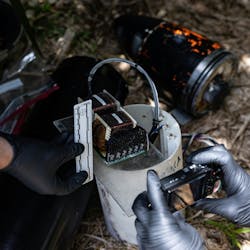Army surveys industry for integrating small, lightweight chemical warfare sensors aboard uncrewed vehicles
FORT DETRICK, Md. – U.S. Army chemical warfare experts will brief industry next week on plans to integrate chemical, biological, radiological, and nuclear (CBRN) sensors aboard uncrewed vehicles to enhance situational awareness for infantry and mobile warfighters on the ground.
Officials of the Edgewood Contracting Division of the Army Contracting Command-Aberdeen Proving Ground Contracting Center at Fort Detrick, Md., will brief industry from 9 a.m. to 4 p.m. on 21 May 2025 virtually via Microsoft Teams on the CBRN Sensor Integration on Robotic Platforms (CSIRP) project.
Industry Day briefings are to identify companies and capabilities to integrate CBRN sensor payloads on uncrewed air, water, and ground vehicles to detect and identify threats collect samples.
These sensors should transmit CBRN data through a common operating picture to provide situational awareness for soldiers operating on foot and in ground vehicles. This project is on behalf of the Joint Program Executive Office for Chemical, Biological, Radiological, and Nuclear Defense (JPEO CBRND), Joint Program Manager, CBRN Sensors (JPM CBRN Sensors).
Capabilities and limitations
Briefings will include a presentation by JPM CBRN Sensors and enable companies to present their capabilities in one-on-one sessions. This effort is to help Army leaders understand the capabilities and limitations of mounting CBRN sensors on uncrewed aircraft, ground vehicles, and surface vessels.
This project involves developing prototype systems, repackaging, integrating hardware and software, and testing to support future employment.
The project has four objectives: biological point detection and identification payloads; microsensor payloads; expanded detection and autonomy capabilities; and command and control integration.
Biological point detection and identification payloads involves developing low-size, -weight, and -power (SWaP) biological detection and identification sensors that can collect and confirm hazards on the battlefield in real time.
Microsensor payloads involves integrating CBRN microsensors onto uncrewed aircraft and ground vehicles for layered defense in CBRN detection and identification.
Expanded detection and autonomy capabilities involves replacing legacy chemical sensors with smaller and more advanced CBRN sensors on uncrewed aircraft and ground vehicles. Interfaces should be platform-agnostic, and advanced software for integration into a common command and control operating picture.
Command and control integration involves developing the ability to make informed, fast decisions on the battlefield using integrated situational awareness on CBRN hazards, and networking CBRN data. Companies ultimately selected for this project will do the work through September 2028.
How to register
Companies interested in attending the industry-day briefings should fill out a registration form online at file:///C:/Users/jkeller/Downloads/CSIRP+Attach+1+Industry+Day+Registration+Form.pdf and return it no later than 15 May 2025 by email to the Army's Richard Totten at [email protected] and Alexander Mayatte at [email protected].
Companies should email white papers no later than 19 May 2025 to Richard Totten at [email protected] and Alexander Mayatte at [email protected].
Email questions or concerns to Richard Totten at [email protected] and Alexander Mayatte at [email protected]. More information is online at https://www.fbodaily.com/archive/2025/05-May/14-May-2025/FBO-07438937.htm.
About the Author
John Keller
Editor-in-Chief
John Keller is the Editor-in-Chief, Military & Aerospace Electronics Magazine--provides extensive coverage and analysis of enabling electronics and optoelectronic technologies in military, space and commercial aviation applications. John has been a member of the Military & Aerospace Electronics staff since 1989 and chief editor since 1995.
